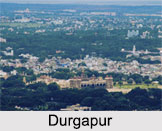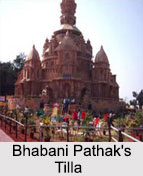 Durgapur is a well-planned industrial city on the banks of the river Damodar. Durgapur is popularly known as the "Steel City of Eastern India" is changing its image. It is emerging in the fields of medical and education to become one of the multipurpose cities of India. Durgapur gives a wide series of opportunities to its residents and visitors from exterior location. Durgapur is the third largest urban gathering in West Bengal.
Durgapur is a well-planned industrial city on the banks of the river Damodar. Durgapur is popularly known as the "Steel City of Eastern India" is changing its image. It is emerging in the fields of medical and education to become one of the multipurpose cities of India. Durgapur gives a wide series of opportunities to its residents and visitors from exterior location. Durgapur is the third largest urban gathering in West Bengal.
Location of Durgapur
Durgapur is situated in the district of Burdwan, in the state West Bengal. It is about 170 kilometres from the city of Kolkata.
Geography of Durgapur
Durgapur is situated at 23.48 degree North and 87.32 degree East. It has an average height of 65 metres (213 feet). Durgapur is in the Paschim Bardhaman district of West Bengal. Durgapur section is bordered with Asansol Sadar subdivision on the West, Purba Bardhaman district on the East, Bankura district across the Damodar in the South, and Birbhum district across the Ajay River to the North.
Climate of Durgapur
Durgapur"s climate is a combination of the tropical wet and dry climate of Kolkata. Summers are tremendously hot and dry with the average daily temperatures near 32 degree Centigrade. Durgapur receives most of its yearly rainfall of about 52 inches during monsoon season.
Demography of Durgapur
In the 2011 census, Durgapur Municipal Corporation had a population of 522,517 out of which 294,255 were males and 272,262 were females. The 0 to 6 years population was 51,930. The literacy rate for the 7+ population was 87.70. According to 2011Census of India, Hinduism is the principal religion in this city, followed by Islam, Christianity, Sikhism, Buddhism, Jainism and others. Out of 5, 66,517 people living in Durgapur (Municipal Corporation); 5, 19,122 are Hindus, 35,923 are Muslims, 1889 are Christians, 2346 are Sikhs, 513 are Buddhists, 382 are Jains.
Education of Durgapur
There are number of colleges and institutes situated in Durgapur. Some of them are as follows:
•National Institute of Technology, Durgapur.
•Durgapur Government College. Now it is allied to Kazi Nazrul University.
•The Central Mechanical Engineering Research Institute.
•Indian Council of Scientific and Industrial Research Centre.
•The National Power Training Institute.
•Kendriya Vidyalaya.
•Jawahar Navodaya Vidyalaya.
•St. Xavier`s School.
•Bidhan Chandra Institution for Boys and Bidhan Chandra Institution for Girls.
Administration of Durgapur
In 1837, when Bankura district was formed, Durgapur region was a part of it. On 14 April 1968, Durgapur subdivision was carved out of Asansol subdivision. After the current Government came to power in West Bengal in 2011, the Asansol Durgapur Police Commission was formed by the State Government in order to get better the law and order situation in the Asansol.
Places of Interest in Durgapur
Some of the popular places of Durgapur are as follows:
•Bhabani Pathak`s Tilla: It is one of Durgapur`s major attractions. The place is a protected monument now. It opens in the city centre area and goes right up to Damodar River.
•Deul Park: The Park is surrounded by Ajoy River. It has been commercialized to have room for a few water rides, a resort, lawns for picnics, etc. 
•Kumaramangalam Park: The Park is one of the biggest in the area with Musical fountains and boating facilities. Located on Tilok Road in Durgapur, the park has two entrances. There is a huge bronze Ganesha Idol inside the park.
•Troinka Park: It is another principal spot of Durgapur. The park offers an absolute leisure time for the visitors with rides, water sports and boating etc.
•Benachity: It`s an established Business Centre. The road is about 3 kilometres in length is lined with traditional shops on both sides. Small merchandise, handicrafts and whole sale items are sold here.
•Garh Jungle: It is also well-known as the Dharma Garh of Raja Surath.
•Ram Mandir: Ram Mandir is very a popular temple of Durgapur. This temple is fully holy place of Durgapur. Each day a very large number of people came here.
•Durgapur Barrage: It is a good place for a day tour and for boating with family and friends.
Visiting Information of Durgapur
The nearest domestic airport of Durgapur is Kazi Nazrul Islam Airport. The airport is 15 kilometres from Durgapur`s City Centre. The city has a well connected and a long stretch of National Highway 2, which is also known as the Delhi - Kolkata road. The railway line in Durgapur is located at 9 kilometres away. It is situated on the road of Howrah to Delhi.



















